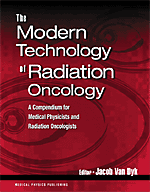
The Modern Technology of Radiation Oncology (softcover)
Author: Jacob Van DykISBN: 9780944838228 ISBN10: 0944838227
Published: 1999 | 1072 pp | Softcover
OUT OF PRINT
ESTRO News | Summer 2000
“The first thing you notice about this book is its size! At 1072 pages it promises to cover a lot of material and it does! It has chapters on almost every area of technology directly involved in radiation oncology that you can think of. Thus you will find patient immobilisation, simulators, CT-simulators, simulator-CT, imaging for planning, treatment planning systems, kV x-rays, cobalt-60, accelerators, beam shaping, portal imaging, brachytherapy, radionuclide therapy, dose measuring tools and more! The preface informs us that the emphasis is on design of equipment, implementation into clinical service and the on-going quality assurance necessary for continued acceptable performance. Most of the listed chapters follow a roughly similar structure to achieve this. They give many practical details which are not provided in most other radiotherapy physics texts. There is an excellent introductory chapter on the clinical implementation of technology and the quality assurance process. This outlines the general framework within which the specific details found in each chapter fit. It also describes various approaches to QA and refers to a range of national and international recommendations on quality assurance in radiotherapy, including those of ESTRO.
“Besides the standard technologies, the book provides reviews of evolving topics of interest or specialist techniques carried out in a smaller number of centres, e.g. intensity modulation, stereotactic irradiation, TBI, TSEI, IORT, etc. Interestingly and unusually for a textbook, it has a chapter on the important and expanding area of radiation oncology information management systems, for which it is difficult to find much information elsewhere in a readily accessible form. In addition , there are reviews of less common topics, obviously written by enthusiasts, e.g. tomotherapy, proton and neutron therapy, hyperthermia, PDT, MNCT and radioimmunotherapy. Here the book tends to depart a little from its declared remit, in that techniques are described, rather than simply technological aspects. This can have a distorting effect on the balance of the book in some instances. As one example, normal external beam clinical applications, dosimetry and treatment planning are not discussed in detail (as opposed to the technology of treatment equipment, dosimetry tools and treatment planning systems), yet clinical application, dosimetry and treatment planning of TBI and TSEI are included in their review chapters. As a second example, obvious from the juxtaposition of two consecutive chapters, radiation oncology information systems are discussed in 11 pages, while tomotherapy is reviewed in 61 pages!
“However these are small criticisms and anyway it is not fair to criticise an abundance of information on some topics, particularly if they are not well reviewed elsewhere! Of course there are also specific points to criticise in a book of this size. A few examples are the fairly superficial coverage of some aspects of planning algorithms such as for electrons or of Monte Carlo approaches, the lack of practical details given on how to measure certain parameters such as kV small field factors, the continuing appearance of Roentgens, etc. Again, though, they are in general small isolated islands of criticism in a well-stocked sea of detailed practical, comprehensive and well-referenced content. However, one significant criticsm is the poor quality of reproduction of many radiographs and photographs.
“The book is written by 56 authors, mainly from N America, but with a handful from Europe and Australia, and is aimed principally at medical physicists. However it will also be of significant interest to radiation oncologists, therapeutic radiographers (radiotherapy technologists), dosimetrists and others involved in the needs-assessment, specification, purchasing, acceptance, commissioning, maintenance, operation, or QA of radiation oncology technology. Size, price and content mean that the book is not so much a teaching text for students, rather it is both a comprehensive reference book for practicing specialists and a valuable source-book for students to support their more main-line teaching texts, providing background and detail. In the preface, the editor states that ‘virtually no textbook addresses the details of acceptance, commissioning and quality assurance of radiation therapy equipment’. Of course, this reviewer can think of at least one!! However the value of the van Dyk compendium lies in its compilation of these aspects for normal modalities, along with good reviews of newer, specialised and developing technologies. The book is not cheap, so possibly not many personal copies will be acquired. However I would recommend it highly as a source book for the department library. I would expect it to be consulted over and over again, as it has the potential to answer many questions that arise in normal practice and also when a department is considering purchasing or implementing any new technologies, be they standard or specialised.”
David Thwaites
Edinburgh, UK


